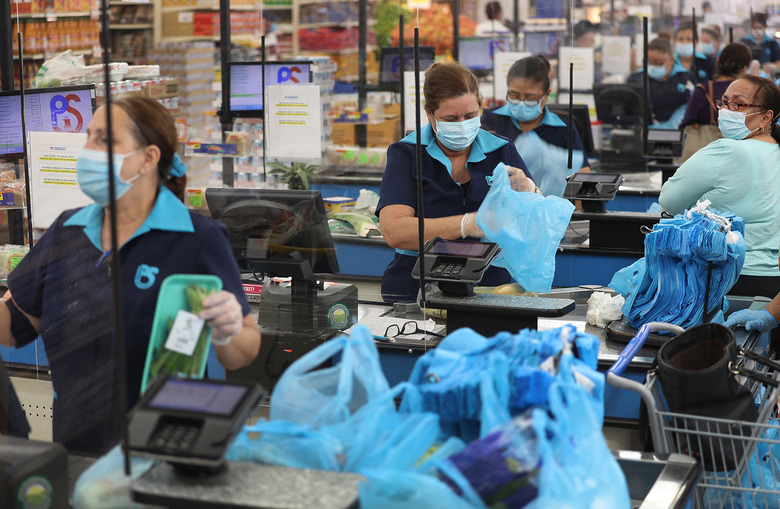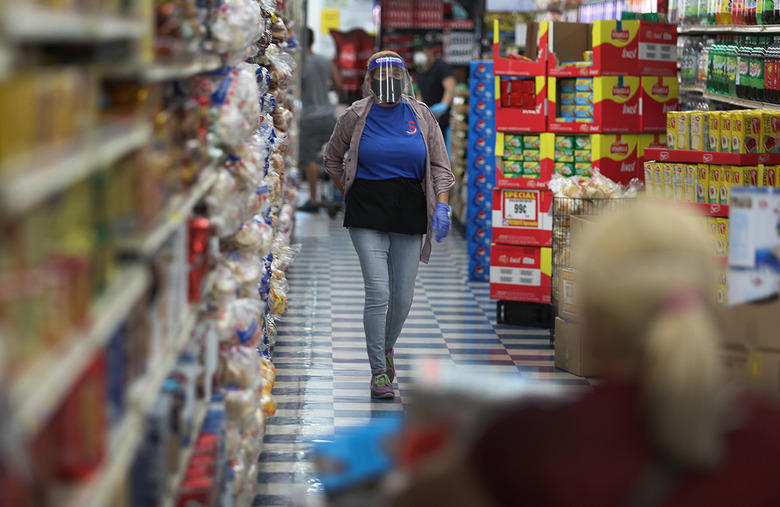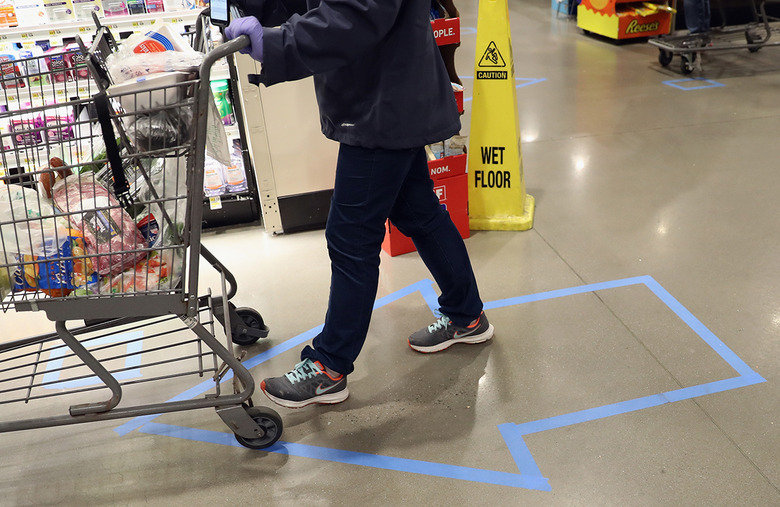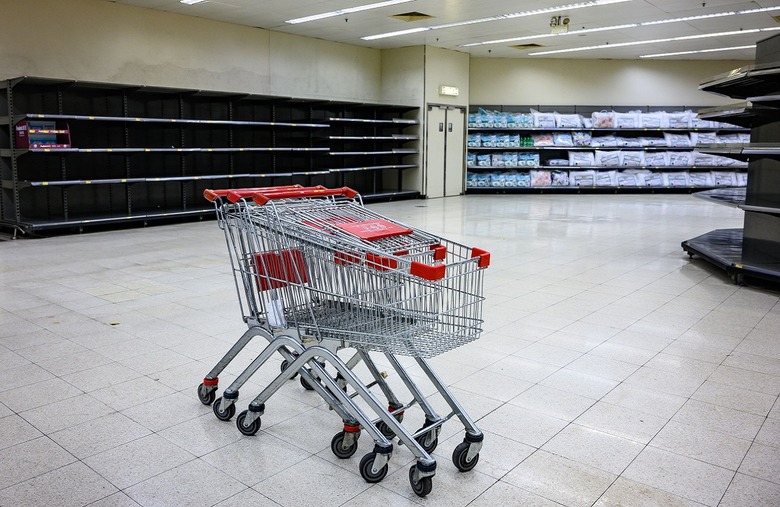Grocery Shopping And Delivery During Coronavirus Comes With Its Pain Points
Although social distancing restrictions have started to ease in certain states, stress over the coronavirus pandemic is still very real for some. A recent study by Datassential, which polled over 3,000 United States consumers, revealed that a trip to the grocery store adds to pandemic stress for a variety of reasons.
A trip to the grocery store can add to stress
The study found that a combination of safety concerns, social distancing issues and long lines has made grocery shopping during the pandemic very stressful. Datassential reports that this strain has impacted millennials and households with kids most. Here are the top concerns Americans have about going to the grocery store.
10. Concern over proper safety precautions
While it's true that some states have been more successful at social distancing than others, 31% of survey respondents said their grocery store doesn't seem to be doing enough to ensure their safety while shopping. This response was more likely among Generation Z, millennials and households with kids.
9. Finances
The coronavirus has put a financial strain on many people. Because of that, 39% of survey respondents said they avoid grocery stores due to finances. This response was more likely among millennials and households with kids.
8. Lack of trust when handling groceries
Of the respondents, 40% said they don't trust grocery store clerks to handle their groceries. Of the Generation Z respondents, 43% said they felt this lack of trust.
7. Lack of trust when getting groceries delivered
In the same vein, 46% of respondents said they don't trust delivery drivers to handle their groceries properly. Of Generation Z respondents, 47% said they felt this lack of trust.
6. Long lines
Forty-seven percent of survey respondents said they avoid certain grocery stores that they would normally shop at now because of long lines. This response was more likely among households with kids.
5. Grocery shopping is a pain
More than half of respondents said they try to stay at home and avoid grocery shopping as much as possible.
4. Grabbing missed items is difficult
According to the survey, 59% of respondents said that picking up a few items they forgot feels difficult and frustrating. Before going shopping, home cooks say it's good practice to make a list of what you need first and to split the list into categories.
3. Lack of trust among fellow shoppers
There are a few ways you may not realize you're being rude at the grocery store. And the survey reported that the majority, 60%, of participants don't trust fellow shoppers to act responsibly while grocery shopping.
2. Safety concerns
Sixty-four percent of responders said they're trying to avoid grocery shopping as much as they can due to safety concerns.
1. Grocery shopping is more stressful since coronavirus
Sixty-six percent of survey takers said that a trip to the grocery store has become increasingly stressful since the coronavirus pandemic.
What are the biggest inconveniences?
Inconveniences being faced by grocery shoppers have added to the stress surrounding a trip to the store. Among the biggest inconveniences are items being out of stock, according to the survey. To counteract this, Costco made a policy limiting shoppers to a certain amount of meat per purchase. Here are the top nine things that have made life difficult for the average shopper.
9. Bagging their own groceries
Twelve percent of millennials said that one of the biggest grocery shopping inconveniences is bagging their own groceries — 8% of overall respondents said they've also found this to be troublesome.
8. Limited access to staff
According to survey takers, 8% said one of the most inconvenient things about grocery shopping is that there's less staff around to answer questions.
7. Reusable bags
Twelve percent of respondents said that not being able to use reusable bags is a disruptive part of grocery shopping during the coronavirus pandemic.
6. Confusion over navigating walkways
Much like restaurants have had to change the way they operate, grocery stores have had to as well. Nearly 20% of survey takers said they've experienced confusion over how to navigate aisles and walkways due to misleading signs and instructions.
5. Changes in hours
Some supermarkets have changed their hours to accommodate the elderly and at-risk customers. Twenty percent of survey participants said that one of the most inconvenient parts about grocery shopping during the pandemic is the change in hours.
4. Lines to access the store
About 20% of respondents said that one of the most distressing parts of grocery shopping is having to wait in lines to get into the store.
3. Lines to check out
In the same vein, 23% of survey participants said one of the most inconvenient parts of grocery shopping is having to wait in lines to check out.
2. Prices seem higher than usual
It's true that prices have risen on popular grocery store items. And survey takers agree — 33% said that prices seem higher than they did prior to the pandemic.
1. Items are out of stock
More than half of the respondents said that one of the most inconvenient parts about grocery shopping during the pandemic is that items they want to buy are out of stock. Among the boomer respondents, 70% said they experienced items being out of stock.
What are the biggest challenges of new safety measures?
According to the survey, safety measures in place at grocery stores are something most shoppers can deal with. But more than a third of people feel like social distancing precautions and wearing a face mask are inconvenient when shopping.
6. Staff improperly handling groceries
Among the total respondents, 9% said they felt staff handled their groceries improperly or unsafely. Households with kids were more likely to feel this way, according to the survey.
5. Limited access to hand sanitizer
Twenty-two percent of survey takers complained that there isn't hand sanitizer dispersed throughout the grocery store.
4. Touching shopping carts
There are many sources of hidden bacteria, and shoppers are concerned about where they could be lurking when at the supermarket. According to the data, 22% of survey participants said that one of the most worrisome parts about grocery shopping is having to touch the shopping carts and baskets.
3. Customers touching things and returning them to shelves
Similarly, 24% of respondents to the survey said one inconvenient part about grocery shopping is customers touching things and returning them to the shelves afterward. This choice was more likely among households with kids.
2. Wearing a mask
Thirty-four percent of respondents said that one of the most disruptive parts about grocery shopping is wearing a mask.
1. It’s hard to social distance
While it's true that some states have more social distancing guidelines than others, 36% of survey respondents said one inconvenient part about grocery shopping is how challenging it is to social distance. This response was more likely among baby boomers.
What are the biggest inconveniences of online shopping?
According to the survey, online shoppers also experienced some inconveniences when purchasing groceries but relatively fewer than when shopping in stores. Here are the top 14 issues people face.
14. Couriers stole items
Of the survey respondents, 5% said that couriers stealing items has been an inconvenient part about ordering groceries online.
13. Items are described poorly
When shopping in person, you can peruse all your options next to each other on the shelf. But 8% of survey participants complain that there is a poor description of items when shopping online. Survey takers said that the size, quantity and varieties included were described poorly.
12. Online apps are hard to navigate
While there are some services offering free delivery through third-party apps, 8% of respondents said they found online apps difficult to navigate.
11. Difficult to get problems resolved
Less than 10% of respondents said that it's been difficult to get problems resolved when ordering groceries online.
10. Communication issues
One way to show your family you love them during the pandemic is by sending them groceries. But there have been some communication issues when ordering groceries online. Nine percent of survey respondents said they don't know whether the order is confirmed or when it will come.
9. Couriers have unsafely handled their groceries
Of the respondents, 9% said couriers have unsafely handled their groceries.
8. Receiving incorrect orders
One of the most inconvenient parts about ordering groceries online is receiving incorrect orders, according to 9% of survey participants.
7. Delivery times are unreliable
Twelve percent of respondents said that unreliable delivery times are among the most inconvenient parts of online grocery shopping.
6. Items have to be substituted
Nine percent of respondents said that one bothersome part about ordering groceries online is having to make substitutions when something you ordered is unavailable.
5. Online prices and in-store prices seem to vary
According to 13% of survey respondents, online prices seem more expensive when ordering groceries for delivery compared to shopping in stores. If you do opt to grocery shop in person, check out our guide for how to cut your bill in half.
4. Long wait times for an open delivery window
Another obstacle when it comes to ordering groceries online has been long wait times for an open delivery window, which 15% of respondents said was among the most inconvenient parts about ordering online.
3. Not able to choose their own items
One of the best parts of grocery shopping is being able to hand-pick the ripest seasonal fruits and vegetables. Fifteen percent of survey takers said not getting to choose their own items like meat and produce is among the most disruptive parts of ordering their groceries online.
2. Extra fees
One of the downfalls to ordering groceries online is the extra fees. According to the study, 15% of respondents experienced surcharges and high delivery costs when ordering their groceries online.
1. There are limited options for online delivery
The most common inconvenience when ordering online groceries, according to 15% of respondents, has been the limited options for online delivery. If you'd rather avoid online shopping and go to the store directly, click here to learn how to make the most out of grocery shopping during the coronavirus pandemic.
More from The Daily Meal:
Coronavirus and Cooking: Bring Your Restaurant Favorites Home With These Meal Kits
Restaurant Reopenings After Coronavirus: These States Are Open to Dine-In
Chain Restaurants Reopening for Dine-In After Coronavirus Pandemic
Coronavirus and Restaurants: Notable Establishments That Have Permanently Closed











































